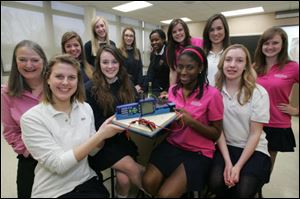
NASA asks St. Ursula to strut science skills
2/16/2010
St. Ursula Academy Science Club members with their NASA's Dropping in a Microgravity Environment entry are, clockwise starting at the center front left of the board, Madeline Niehaus, 16, Abby Rieker, 17, holding the board's left corner, adviser Jackie Kane, Sydney Schwab, 16, Gretchen Savage, 16, Stephanie N. Szczesniak, 16, Nicole Ishimwe, 15, Cassie Pacer, 17, Liz Garrison, 17, Shannon Martin, 17, Danyel E. Wigmans, 14, and Nikeya Dickson, 18, holding the board's right corner.
The microgravity experiment that a science club at St. Ursula Academy has created takes just 2.2 seconds to test, but it will give four of the students an opportunity of a lifetime.
And depending on its results, the experiment could change how medicines and other liquids are developed and administered in the weightless environment of space.
St. Ursula's club is one of four such high-school groups from across the United States chosen by NASA to send a four-person delegation to the Glenn Research Center near Cleveland in April to conduct experiments the groups developed themselves, following space-agency guidelines, and entered in a competitive selection process.
Teams from nine high schools will enter their experiments to Glenn for the weeklong "Dropping in a Microgravity Environment" event, but only the four St. Ursula students and counterparts from schools in Northbrook, Ill., Plattsburgh, N.Y., and Tualatin, Ore., will be there as National Aeronautics and Space Administration staff rig their materials up in a 78-foot drop tower that simulates near-zero gravity for 2 1/2 seconds of free fall.
"My biggest fascination is that NASA might test this," said Sydney Schwab, 16, of Toledo, who was one of 11 students to participate in the experiment's development. "Maybe it might go up into space someday."
The St. Ursula team's experimental goal is to determine if the molecules in liquids spin at a different speed under microgravity conditions than they do at normal gravity, which could affect those liquids' properties in the space environment.
To test this, the team rigged up a foot-square platform - the maximum size allowed by NASA - that holds a small vial of fluorescent dye and a light-metering device. During the experiment, a blue light will shine through the fluorescent liquid to excite its molecules.
The speed at which they spin while the whole assembly is dropped in NASA's tower will be compared with their spinning speed under normal gravity. The experimental system also measures electrical voltage and temperature so those factors can be controlled for.
The experiment was the last of several concepts the team worked on during after-school sessions - on the girls' own time - in compliance with guidelines from a NASA Web site. Experiment proposals were submitted to NASA in November, and the St. Ursula team found out it had a winning idea a week before Christmas.
Cassie Pacer, 17, of Toledo, said that while the team was confident about its work, it was still a happy shock to be chosen.
"We worked so hard through all our high school years. Now we'll be able to apply this knowledge to our project," she said.
"We were so excited. This is a national thing," agreed Nicole Ishimwe, 15, of Toledo.
Jackie Kane, science department chairman, said in comparison with sports trophies, honors for academics are fewer and farther between, which made this one special.
"This is a trophy for knowing something, a reward for academic achievement," the teacher said of the NASA funded trip that four of the team's members will take from April 19-23.
Exactly who gets to spend the entire week of April 19 at the Glenn center, though, remains to be determined.
It may turn out, the teacher said, that there is no gravity-driven difference in molecular behavior, or at least a difference too small to be measured by the group's method.
"We don't know if we'll get a difference," the teacher said, comparing her students' experiment with "cookbook labs" used in normal classwork that are designed to get observable results.
And with the competitive aspect of the DIME program over, Mrs. Kane said, the Glenn experience will be "pure science."
But if the experiment reveals the sought-after difference in molecular behavior, she said, then that provides a starting point for additional research.
"If they get something that is scientifically valid, it will go further," she said.